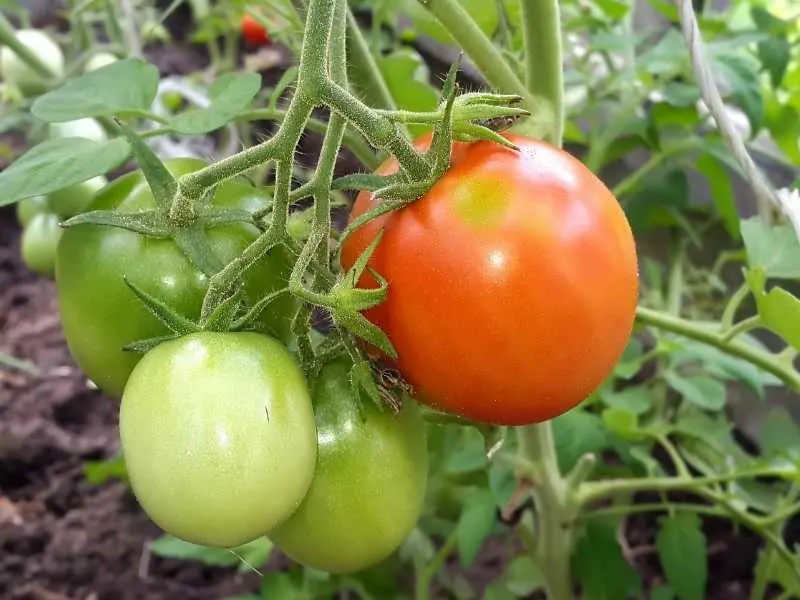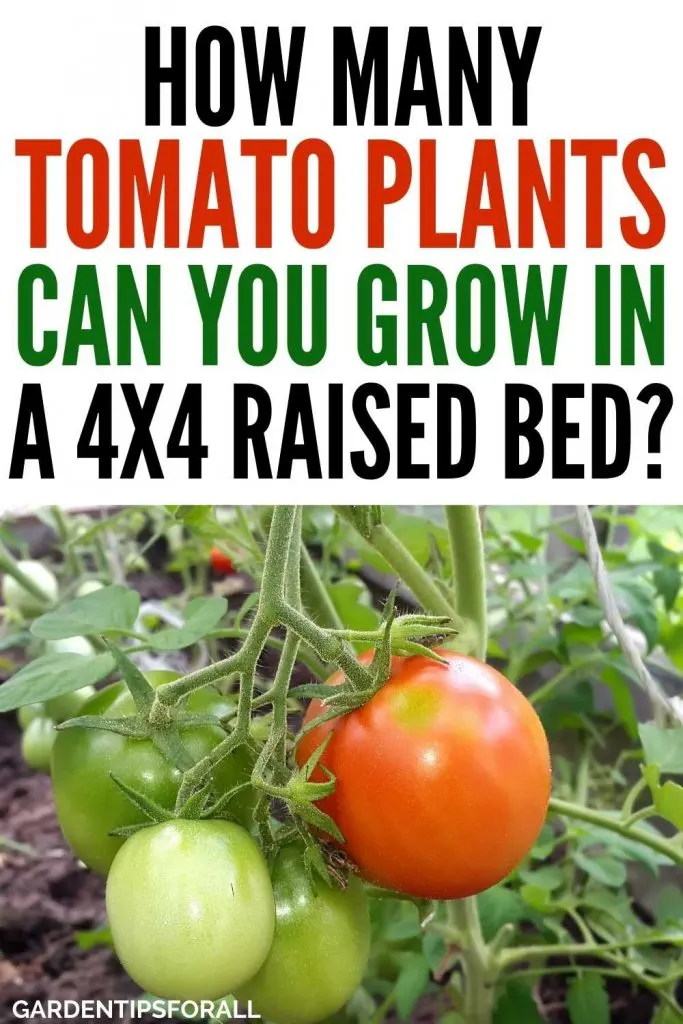How Many Tomato Plants Can You Grow in a 4×4 Raised Bed?
Growing tomatoes in a raised garden bed is one of the best and easiest gardening methods.
You get to use better soil than the one in your garden. And there’s less weeding and tilling required. Just add some mulch or compost at the beginning of each season, and you’ll be good to go.
But you may be wondering how many tomato plants you can you grow in a raised garden bed without overcrowding.
A 4×4 raised bed is 16 square feet in size. Most tomatoes require at least 4 square feet to grow. Based on this estimate, you can grow 4 to 5 tomato plants on a 4×4 raised garden bed – one in the middle and one on each corner of the bed. However, factors such as the tomato variety also determine how to space the tomato plants.
I will discuss these factors in detail and share some tips on how to grow more tomatoes in raised garden beds.

Related Article:
What’s the Best Spacing for Tomatoes on a Raised Garden Bed?
There are two primary varieties of tomatoes. And both are spaced differently.
Determinate Tomatoes
This variety grows for a definite period. Their fruits ripen within a few weeks, and once you harvest them, the plant stops growing.
They also don’t grow very large (about 4 to 5 feet). That’s why they’re also referred to as “bush” tomatoes.
You also don’t have to prune these tomato plants since they’ll stop growing on their own.
You can leave a spacing of at least 36 to 48 inches (3 to 4 feet) from one plant to the other for this variety. This translates to 4 plants in a 4×4 raised garden bed.
But you can also trellis your tomatoes (or use cages) to make sure they don’t sprawl on the ground.
This practice is recommended because they grow several tomatoes that weigh them down even though they have a compact size.
Trellising also allows you to plant at least one or two more plants in the raised garden bed. But make sure you feed the soil a lot of nutrients due to the additional plants.
The determinate variety is ideal for those who want to harvest many tomatoes at once for canning, making sauce, or juice.
Below are some of the most common determinate tomatoes.
- Rutgers
- San Marzano
- Celebrity
- Marglobe
- Amish Paste
Indeterminate Tomatoes
The indeterminate tomato doesn’t stop its growth. Instead, it grows continuously until frost sets in, and then it dies.
Instead of giving you one large harvest, you get small, consistent yields throughout the season. Also known as “vining” tomatoes, this variety can grow as tall as 10 feet.
However, since they spend some time and energy growing taller, the tomato fruits ripen later than the determinate variety.
Pruning is also necessary to manage how big these plants will grow and ensure a larger harvest.
Just like in the determinate tomatoes, it would be best to use trellis or cages to support them as they grow. 3 to 4 feet is still the appropriate spacing, and you’ll get 4 to 5 plants in your raised bed.
Without the trellis, you’ll only get 2 to 3 plants.
Most tomatoes belong to the indeterminate variety. Some of the most common include;
- Cherry tomatoes
- Heirloom tomatoes
- Brandywine
- Big Boy
- BeefSteak
- Sweet Million
- Sungold
How Wide Should a Raised Bed for Tomatoes be?
4 feet long and 4 feet wide is the ideal size to make it easier to reach the plants and cultivate the soil.
If you’re building several raised garden beds, don’t place them too close together. When there’s no space to walk through, you won’t reach some of the plants.
So, leave at least a 30 inches distance between each raised bed.
How Deep Should a Raised Garden Bed for Tomatoes be?
A 12 inches deep garden is ideal for most plants, including tomatoes and vegetables.
But some people build up to 18 inches deep. That being said, as long as you have well-drained soil, 12 inches is enough.
What Happens if You Plant Tomatoes too Close Together?
Too many tomato plants will compete for the limited nutrients including water, air, and sunlight. As a result, they won’t grow as required, and they won’t produce enough fruits.
Lack of airflow and sunlight may also cause diseases such as wilts.
And if the tomatoes are crowded, it will also be difficult to harvest them, making them more susceptible to damage.
NOTE: Some vendors advertise that their varieties can be planted in 1 square foot for each plant. While that may be true, it’s risky, and you may never harvest any fruits from such an arrangement. It’s best to stick to the 4 square feet per plant guideline.
Tips for Growing Tomatoes in a 4 ft by 4ft Raised Garden Bed
Below are some tips to help you get bigger and more tomatoes from your raised gardens.
Use the Appropriate Soils
Tomatoes will grow best in slightly acidic, well-drained soils (pH 6 -7). Due to the limited space, the bed can’t hold a lot of nutrients.
You should add fertilizer (preferably organic fertilizer or compost) often. Applying fertilizer to the soil at the beginning of every season would also be great.
Related Articles:
Prune! Prune! Prune!
You have to continually remove the suckers (the sprouts that appear between the branch and the stem). But be careful not to prune directly under a blossom. Doing so will lead to lower harvests.
Water from the Base
Watering from the top is easy and may seem like a good idea. But it’s not. You may sprinkle some water on the leaves, providing a medium for soil-borne diseases.
And the water may not always get to the roots. But you can set a system that waters the base of the plants. Here’s a good example.
Crop Rotation
Rotating crops works great on regular gardens, and it’s even easier on raised gardens since you can label where you planted a particular crop.
A general rule is that you should plant the same crop on the same soil once every 2 to 3 years. Rotation is essential since plants use different nutrients.
And it helps to eliminate crop-specific pests and diseases that are left in the soil after harvesting.
You can rotate tomatoes with other vegetables now and then.
Install the Cages/Trellis as Soon as Possible
If you install the cages when the tomato plants are all grown, you risk snapping and breaking them.
Set them up when plants are small, and be careful not to damage the cages, especially if the soil beneath is hardened.
Till and Clean Up the Garden after Harvesting
Remove any dead plants and rotten fruits and combine them in your compost. If they decompose in the garden, you might find small tomato plants within the plants you will be growing next season.
Conclusion
I hope that clears everything up. Growing more plants in a small area doesn’t guarantee more tomato fruits. You should plant a maximum of five plants in a 4×4 raised garden bed. And with the right soil and watering conditions and selecting a suitable tomato variety, you can tell success stories like this one. The gardener harvested 300 pounds of tomatoes from a 4×4 raised garden. And he only had 4 plants in each garden.

